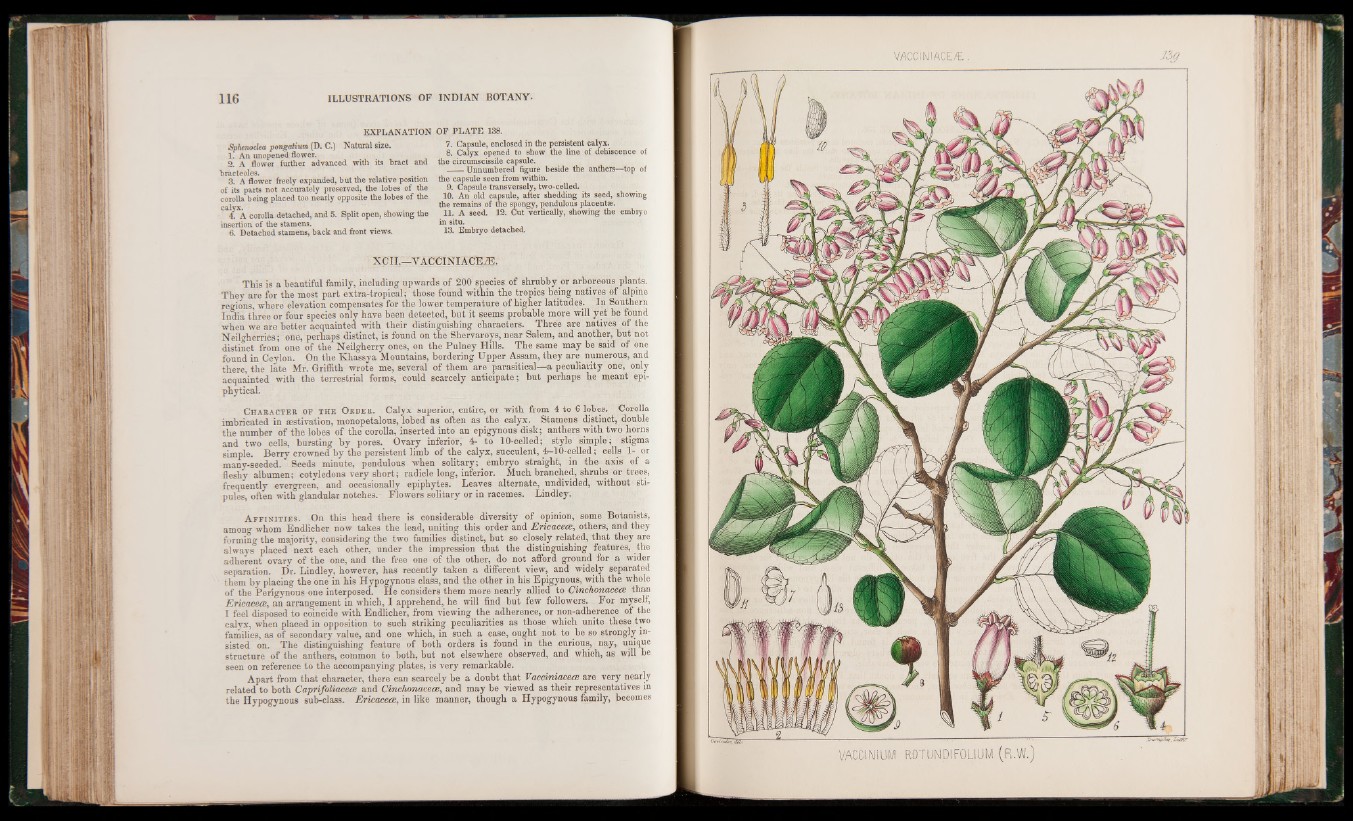
EXPLANATION OF PLATE 138.
Sphenocka pongatium (D. C.) Natural size.
1. An unopened flower.
2. A flower further advanced with its bract and
bracteoles.
3. A flower freely expanded, but the relative position
of its parts not accurately preserved, the lobes of the
corolla being placed too nearly opposite the lobes of the
calyx.
4. A corolla detached, and 5. Split open, showing the
insertion of the stamens.
6. Detached stamens, back and front views.
7. Capsule, enclosed in the persistent calyx.
8. Calyx opened to show the line of dehiscence of
the circumscissile capsule.
------Unnumbered figure beside the anthers—top of
the capsule seen from within.
9. Capsule transversely, two-celled.
10. An old capsule, after shedding its seed, showing
the remains of the spongy, pendulous placentae.
11. A seed. 12. Cut vertically, showing the embryo
in situ.
13. Embryo detached.
XCII.—VACCINIACEJE.
This is a beautiful family, including upwards of 200 species of shrubby or arboreous plants.
They are for the most part extra-tropical; those found within the tropics being natives of alpine
regions, where elevation compensates for the lower temperature of higher latitudes. In Southern
India three or four species only have been detected, but it seems probable more will yet be found
when we are better acquainted with their distinguishing characters. Three are natives of the
Neilgherries; one, perhaps distinct, is found on the Shervaroys, near Salem, and another, but not
distinct from one of the Neilgherry ones, on the Pulney Hills. The same may be said of one
found in Ceylon. On the Khassya Mountains, bordering Upper Assam, they are numerous, and
there, the late Mr. Griffith wrote me, several of them are parasitical—a peculiarity one, only
acquainted with the terrestrial forms, could scarcely anticipate; but perhaps he meant epiphytical.
Character oe the Order. Calyx superior, entire, or with from 4 to 6 lobes. Corolla
imbricated in motivation, monopetalous, lobed as often as the calyx. Stamens distinct, double
the number of the lobes of the corolla, inserted into an epigynons disk; anthers with two horns
and two cells, bursting by pores. Ovary inferior,- 4- to 10-celled; style simple; stigma
simple. Berry crowned by the persistent limb of the calyx, succulent, 4-1O-celled; cells 1- or
many-seeded. Seeds minute, pendulous when solitary; embryo straight, in the axis of a
fleshy albumen; cotyledons very short; radicle long, inferior. Much branched, shrubs or trees,
frequently evergreen, and occasionally epiphytes. Leaves alternate, undivided, without stipules,
often with glandular notches. Flowers solitary or in racemes. Lindley.
Affinities. On this head there is considerable diversity of opinion, some Botanists,
among whom Endlicher now takes the lead, uniting this order and Ericacete, others, and they
forming the majority, considering the two families distinct, but so closely related, that they are
always placed next each other, under the impression that the distinguishing features, the
adherent ovary of the one, and the free one of the other, do not afford ground for a wider
separation. Ur. Lindley, however, has recently taken a different view, and widely separated
them by placing the one in his Hypogynous class, and the other in his Epigynous, with the whole
of the Perigynous one interposed. He considers them more nearly allied to Cvnchonacecc than
Ericacecc, an arrangement in which, I apprehend, he will find but few followers. For myself,
I feel disposed to coincide with Endlicher, from viewing the adherence, or non-adherence of the
calyx, when placed in opposition to such striking peculiarities as those which unite these two
families, as of secondary value, and one which, in such a case, ought not to be so strongly insisted
on. The distinguishing feature of both orders is found in the curious, nay, unique
structure of the anthers, common to both, but not elsewhere observed, and which, as will be
seen on reference to the accompanying plates, is very remarkable.
Apart from that character, there can scarcely be a doubt that Vacciniacets are very nearly
related to both Caprifiliac.ea‘. and Cinchonacece, and may be viewed as their representatives in
the Hypogynous sub-class. Ericaceae, in like manner, though a Hypogynous family, becomes
VACCINIACEÆ.
VACCINIUM ROTUNpiFOLIUM (R.W.)